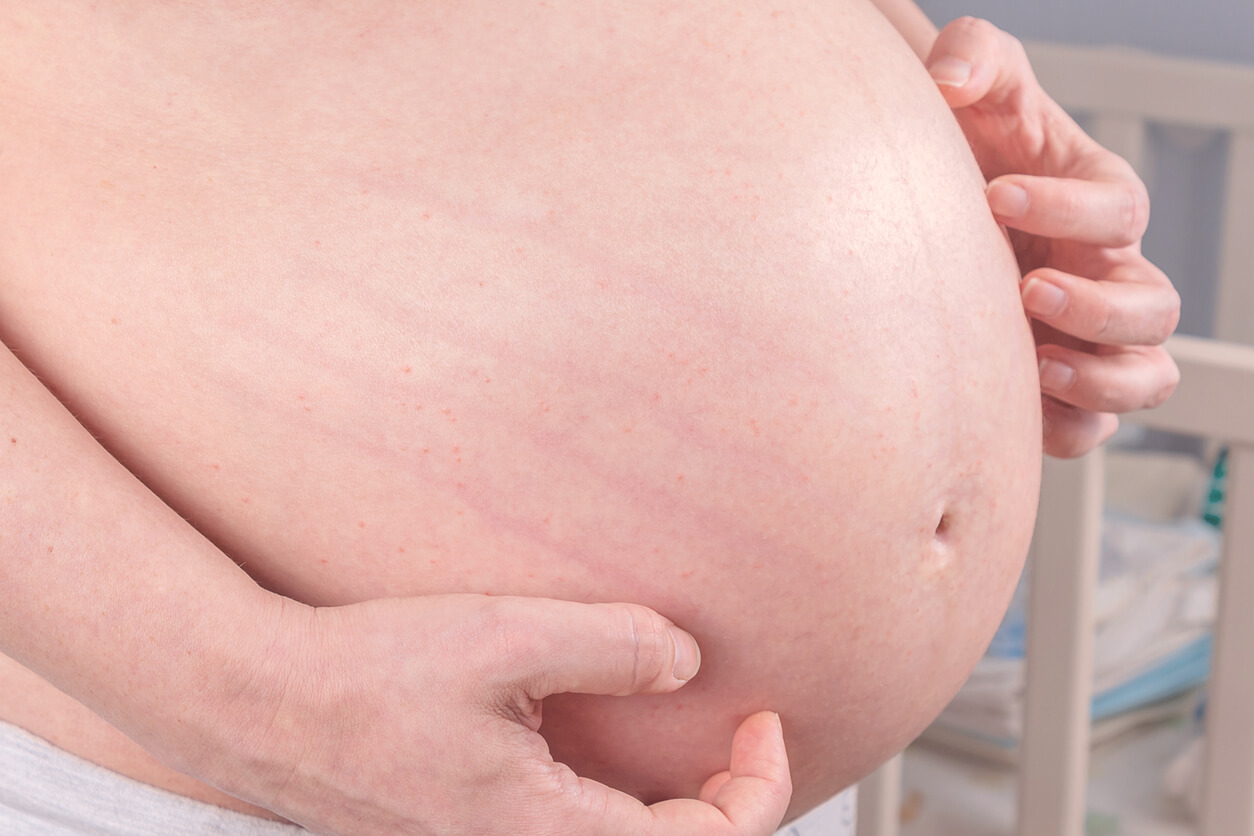10 Interesting Facts About Your Skin When You're Pregnant


Written and verified by the dermatologist Maria del Carmen Hernandez
During pregnancy, your skin may present changes or alterations that are characteristic of this moment. Although they’re not serious, it’s good to know about them to know how to handle them. With that in mind, we want to share with you 10 interesting facts about your skin when you’re pregnant.
Are you interested? Keep reading!
10 interesting facts about your skin when you’re pregnant
The skin is the largest organ of the body and has the ability to adapt to different situations and environments. In fact, your skin during pregnancy can manifest various changes that you might not be aware of. Take note!
1. Transient abdominal hyperpigmented line
Before pregnancy, the linea alba is clear and usually goes unnoticed from the navel to the pubis. In contrast, during the gestation period, it darkens and acquires the name linea nigra. This usually appears around the second trimester due to obvious hormonal changes.
2. Increases skin radiance
The skin of pregnant women is characterized by a special glow. On the one hand, this is due to hormonal changes that stimulate the production of sebum by the sebaceous glands, as explained in a publication in the Indian Journal of Dermatology, Veneorology and Leprology. On the other hand, the blood flow in the superficial layers of the skin is increased, which also increases the oxygenation of the skin cells.
3. Heat rashes are common
Skin rashes are triggered by sweating and as a result of heat. It’s also common for itchy rashes to appear in the abdominal region, and they may spread to the legs, buttocks, and arms. However, these types of lesions aren’t serious.
You may be interested in: Skin Exfoliation During Pregnancy: Everything You Need to Know

4. Spots or moles appear
Spots of different types are also common, especially in the facial area. Although they usually disappear after childbirth, it’s best to try to prevent them with the daily and frequent use of sunscreen.
Hyperpigmented spots appear, in most cases, during the last two trimesters of pregnancy. They can also occur due to the associated genetic factor.
5. Acne outbreaks are characteristic
Minimal acne lesions are common during the first months of pregnancy. However, in women who already had acne outbreaks before becoming pregnant, the condition may improve with pregnancy.
The probable cause is the excessive stimulation of sebum production by the sebaceous glands.
6. The skin suffers micro-traumas
Stretch marks often appear on various parts of the body during pregnancy. In fact, they’re generated by the rupture of collagen and elastin fibers as a result of abrupt or excessive stretching of the skin.
The areas most likely to appear are the breasts, abdomen, thighs, and buttocks. Initially, they’re purplish and then turn whitish.
7. Stretch marks are differentiated by location
The skin undergoes different healing processes in different parts of the body. In the face of any factor that attacks it, the repair processes begin, but the speed and intensity vary according to the region of the body. The neck and chest areas are one of the areas most at risk of developing hypertrophic or keloid scars.
Read also: Oily Skin During Pregnancy: Advice and Care

8. Your skin has memory
The spots are caused by the alteration of pigment cells, i.e. melanocytes. When they’ve been treated and their pigmentation has been greatly diminished, their information remains latent and can become pigmented again during pregnancy or sun exposure.
Therefore, the American College of Obstetricians and Gynecologists recommends the constant use of sunscreens and avoiding prolonged exposure to ultraviolet rays.
9. The thickness of the skin varies in different areas
The thickness of the skin surface differs according to the area in question. For example, the skin on the abdomen is thin enough to allow the baby to develop properly, while the skin on the sole of the feet is the thickest.
The skin acts as a protective barrier in the body, which is why its thickness is different in each area. Even along its entire length, other skin characteristics such as color and texture vary.
10. Your best ally is sunscreen
Sunscreen should be used continuously to protect the skin surface and the hyperpigmented spots that may appear. We recommend broad-spectrum filters that provide protection against UVA and UVB rays, with a sun protection factor (SPF) of 30 or higher.
Mineral sunscreens are the most recommended for pregnant or breastfeeding women. They should be applied 15 minutes before exposure to ultraviolet rays and reapplied every 2 hours.
Skincare is fundamental
It’s not easy to know which changes will appear on pregnant women’s skin, however, some can be easily prevented.
It’s best to moisturize the skin daily with creams–especially on the abdomen–drink plenty of fluids, and avoid the heat.
During pregnancy, your skin may present changes or alterations that are characteristic of this moment. Although they’re not serious, it’s good to know about them to know how to handle them. With that in mind, we want to share with you 10 interesting facts about your skin when you’re pregnant.
Are you interested? Keep reading!
10 interesting facts about your skin when you’re pregnant
The skin is the largest organ of the body and has the ability to adapt to different situations and environments. In fact, your skin during pregnancy can manifest various changes that you might not be aware of. Take note!
1. Transient abdominal hyperpigmented line
Before pregnancy, the linea alba is clear and usually goes unnoticed from the navel to the pubis. In contrast, during the gestation period, it darkens and acquires the name linea nigra. This usually appears around the second trimester due to obvious hormonal changes.
2. Increases skin radiance
The skin of pregnant women is characterized by a special glow. On the one hand, this is due to hormonal changes that stimulate the production of sebum by the sebaceous glands, as explained in a publication in the Indian Journal of Dermatology, Veneorology and Leprology. On the other hand, the blood flow in the superficial layers of the skin is increased, which also increases the oxygenation of the skin cells.
3. Heat rashes are common
Skin rashes are triggered by sweating and as a result of heat. It’s also common for itchy rashes to appear in the abdominal region, and they may spread to the legs, buttocks, and arms. However, these types of lesions aren’t serious.
You may be interested in: Skin Exfoliation During Pregnancy: Everything You Need to Know

4. Spots or moles appear
Spots of different types are also common, especially in the facial area. Although they usually disappear after childbirth, it’s best to try to prevent them with the daily and frequent use of sunscreen.
Hyperpigmented spots appear, in most cases, during the last two trimesters of pregnancy. They can also occur due to the associated genetic factor.
5. Acne outbreaks are characteristic
Minimal acne lesions are common during the first months of pregnancy. However, in women who already had acne outbreaks before becoming pregnant, the condition may improve with pregnancy.
The probable cause is the excessive stimulation of sebum production by the sebaceous glands.
6. The skin suffers micro-traumas
Stretch marks often appear on various parts of the body during pregnancy. In fact, they’re generated by the rupture of collagen and elastin fibers as a result of abrupt or excessive stretching of the skin.
The areas most likely to appear are the breasts, abdomen, thighs, and buttocks. Initially, they’re purplish and then turn whitish.
7. Stretch marks are differentiated by location
The skin undergoes different healing processes in different parts of the body. In the face of any factor that attacks it, the repair processes begin, but the speed and intensity vary according to the region of the body. The neck and chest areas are one of the areas most at risk of developing hypertrophic or keloid scars.
Read also: Oily Skin During Pregnancy: Advice and Care

8. Your skin has memory
The spots are caused by the alteration of pigment cells, i.e. melanocytes. When they’ve been treated and their pigmentation has been greatly diminished, their information remains latent and can become pigmented again during pregnancy or sun exposure.
Therefore, the American College of Obstetricians and Gynecologists recommends the constant use of sunscreens and avoiding prolonged exposure to ultraviolet rays.
9. The thickness of the skin varies in different areas
The thickness of the skin surface differs according to the area in question. For example, the skin on the abdomen is thin enough to allow the baby to develop properly, while the skin on the sole of the feet is the thickest.
The skin acts as a protective barrier in the body, which is why its thickness is different in each area. Even along its entire length, other skin characteristics such as color and texture vary.
10. Your best ally is sunscreen
Sunscreen should be used continuously to protect the skin surface and the hyperpigmented spots that may appear. We recommend broad-spectrum filters that provide protection against UVA and UVB rays, with a sun protection factor (SPF) of 30 or higher.
Mineral sunscreens are the most recommended for pregnant or breastfeeding women. They should be applied 15 minutes before exposure to ultraviolet rays and reapplied every 2 hours.
Skincare is fundamental
It’s not easy to know which changes will appear on pregnant women’s skin, however, some can be easily prevented.
It’s best to moisturize the skin daily with creams–especially on the abdomen–drink plenty of fluids, and avoid the heat.
All cited sources were thoroughly reviewed by our team to ensure their quality, reliability, currency, and validity. The bibliography of this article was considered reliable and of academic or scientific accuracy.
- Skin conditions during pregnancy. [Internet]. Disponible en: https://www.acog.org/womens-health/faqs/skin-conditions-during-pregnancy?utm_source=redirect&utm_medium=web&utm_campaign=otn
- Kumari R, Jaisankar TJ, Thappa DM. A clinical study of skin changes in pregnancy. Indian J Dermatol Venereol Leprol. 2007 Mar-Apr;73(2):141. doi: 10.4103/0378-6323.31910. PMID: 17458033.
-
Basit H, Godse KV, Al Aboud AM. Melasma. [Updated 2022 Jun 7]. In: StatPearls [Internet]. Treasure Island (FL): StatPearls Publishing; 2022 Jan-. Available from: https://www.ncbi.nlm.nih.gov/books/NBK459271/
This text is provided for informational purposes only and does not replace consultation with a professional. If in doubt, consult your specialist.








